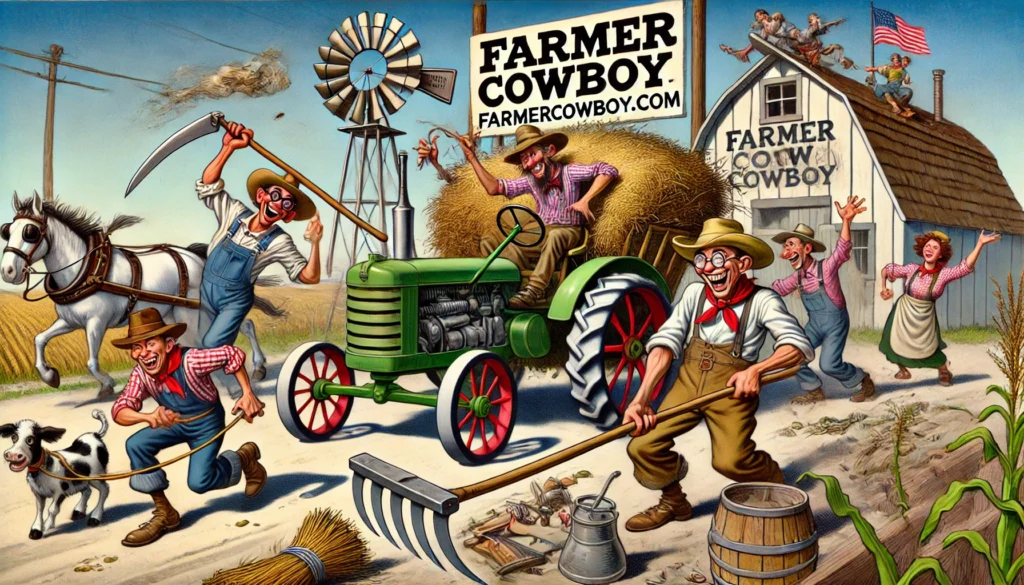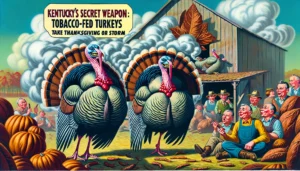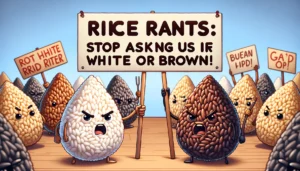
Retro Farming A wide aspect satirical cartoon in the style of FarmerCowboy.com with farmercowboy.com branding. The image shows a humorous scene of vintage farming with4.webp.webp
Retro Farming: Bringing Back the Good Old Days – How Farmers Are Turning Back the Clock to Survive the Economic Downturn
From Horse-Drawn Plows to Homemade Butter: Why the Future of Farming Might Just Look Like the Past
Rustic Ridge, KY – In the face of rising costs, unpredictable markets, and technological overload, farmers across the country are saying goodbye to the latest innovations and hello to a simpler time. Welcome to the world of Retro Farming, where horse-drawn plows, hand-cranked butter churns, and seed-saving swaps are more than just novelties – they’re necessities.While some may scoff at the idea of going backward to move forward, for many farmers, it’s not just a trend – it’s survival. “The way things are going, I figured I might as well embrace the old ways,” says Farmer John, a third-generation farmer who recently traded in his high-tech tractor for a pair of sturdy draft horses. “Sure, they’re slower, but they don’t need gas, and they’ve got a lot more personality.”
When tractors get too expensive, it’s time to dust off the old horse and plow. Who needs diesel when you’ve got hay?
Horsepower, Literally: The Return of the Plow Horse
Across the fields of Kentucky, Ohio, and beyond, farmers are swapping out their expensive, fuel-guzzling tractors for trusty steeds. “I’ve got Bessie and Belle,” says Farmer John, patting the necks of his two horses. “They don’t break down, and they’re a lot cheaper to feed than a tractor.”
John’s not alone. A growing number of farmers are turning to horse-drawn plows as fuel prices skyrocket. “It’s funny,” says Mary, a neighboring farmer. “My grandpa used to talk about plowing with horses, and now here I am doing the same thing. Who knew Grandpa was ahead of his time?”

Nostalgic or Necessary?
The rise of Retro Farming has garnered mixed reactions from the public. Some see it as a quaint throwback, while others recognize it as a practical response to tough economic times. “It’s easy to romanticize the past, but for these farmers, it’s not just about nostalgia,” says Hank, a local agricultural expert. “They’re doing what they have to do to survive.”
Even those who initially resisted the idea are coming around. “I used to think it was crazy,” says Tom, another farmer who’s recently joined the Retro Farming movement. “But now that I’m milking cows by hand and growing my own feed, I realize there’s something satisfying about it. Plus, my fuel costs are down to zero.”

The Benefits of Going Backwards
Dr. Eliza Greenfield, an agricultural historian, sees the shift toward Retro Farming as part of a larger trend in sustainable agriculture. “What we’re witnessing is a return to practices that are not only environmentally friendly but also economically viable,” she explains. “Farmers are finding that the old ways still work, and in some cases, they work better than the modern alternatives.”
Dr. Greenfield points to the resurgence of seed-saving as an example. “Farmers are trading heirloom seeds, preserving genetic diversity, and creating resilient crops,” she says. “It’s a practice that’s been around for centuries, but it’s making a comeback because it makes sense.”
Stories from the Retro Revolution
The stories coming out of the Retro Farming movement are as varied as the farmers themselves. Take the case of Sue and Bill, a couple who traded their suburban life for a small farm in upstate New York. “We started canning our own vegetables and making butter by hand,” says Sue. “At first, it was just a fun experiment, but now we’re hooked. It’s hard work, but it’s worth it.”
Then there’s Earl, a farmer in the Midwest who’s taken to raising chickens and building his own coops. “I never thought I’d be the guy with a bunch of chickens running around, but here I am,” he laughs. “The eggs are great, and the chickens are better company than most people I know.”

The Numbers Behind the Nostalgia
According to a recent survey by the National Farming Association, 25% of farmers have adopted at least one “retro” practice in the past year. Whether it’s growing their own food, raising livestock by hand, or using low-tech tools, these farmers are finding that the old ways have a lot to offer.
“Retro Farming isn’t just a fad,” says Jim, a spokesperson for the association. “It’s a response to real challenges in the farming sector. When times are tough, you do what you have to do. And if that means dusting off the butter churn, so be it.”
The Wisdom of the Past
The Retro Farming movement is backed by a wealth of historical wisdom. From old farming manuals to family recipes, farmers are rediscovering the techniques that sustained their ancestors. “There’s a lot of knowledge in those old books,” says Dr. Greenfield. “We’ve lost some of it in the rush to modernize, but it’s still there if you know where to look.”
And it’s not just the books that are making a comeback. Grandma’s recipes, long forgotten in the age of convenience foods, are now prized possessions. “I found my granny’s cookbook in the attic,” says Jane, a farmer in Tennessee. “It’s got everything from how to make butter to canning instructions. It’s like a treasure trove.”

Comparing the Past and Present: Why Retro Works
While some may view Retro Farming as a step backward, others see it as a way to move forward in a more sustainable and resilient manner. The comparison to modern farming practices is stark: high-tech machinery, genetically modified seeds, and industrial-scale production vs. manual labor, heirloom seeds, and small-scale farming.
“It’s not about rejecting progress,” says Farmer John. “It’s about finding a balance. The old ways worked for a reason, and they’re working for us now.”

The Future of Retro Farming
As the economic downturn continues, more farmers are likely to embrace Retro Farming. The question is, how far will it go? Will we see a return to barter systems, or perhaps a revival of the neighborhood barn-raising party?
“I wouldn’t be surprised,” says Hank. “The way things are going, we might all be learning how to plow a field with a mule before long. But hey, at least we’ll be ready.”

Step-by-Step Guides and Pro Tips for Farmers & Cowboy Readers
- Pro Tip: Start small. You don’t need to go full retro all at once. Try growing your own vegetables or raising a few chickens before committing to the whole shebang.
- Insider Knowledge: Horsepower isn’t just a figure of speech. Draft horses can be a viable alternative to tractors if you’re willing to put in the time.
- Practical Advice: Don’t underestimate the value of old tools. That rusty scythe in the barn? It’s still good for something.
- Best Practices: Save your seeds. Heirloom varieties are more than just a trend – they’re a way to ensure a resilient crop.
- Solutions-Oriented Approach: When in doubt, ask the older generation. They’ve been there, done that, and can probably teach you a thing or two about making do.

Disclaimer
This article is a satirical take on the Retro Farming movement. While the challenges facing the farm sector are real, and some farmers are indeed revisiting older practices, we’re not suggesting that everyone will be trading in their tractors for plow horses anytime soon. Any resemblance to actual farmers dusting off their butter churns or leading barn-raising parties is purely coincidental – though if you do end up canning your own vegetables, more power to you!

15 Historical Retro Observations:
- Horsepower, Literally: When tractors get too expensive, it’s time to dust off the old horse and plow. Who needs diesel when you’ve got hay?
- Amish Envy: Turns out, the Amish had it right all along – no fuel costs, just pure elbow grease.
- Grandpa’s Gadgets: That rusty old butter churn? It’s now the latest high-tech farming equipment.
- Seed Swap Meets: Forget fancy GMOs – these farmers are trading seeds like baseball cards. Heirloom tomatoes, anyone?
- Back to Basics: When in doubt, milk a cow. At least it doesn’t require a Wi-Fi connection.
- The New Green Deal: It’s called a pasture, and it’s where your cows used to graze before they started demanding climate-controlled barns.
- Barn Raising Parties: Why pay for construction when you can throw a barn-raising party? BYO hammer.
- Rotary Phones & Radio Shows: Who needs smart devices when you’ve got good old-fashioned gossip on the farm line?
- Canning Craze: The newest craze? Canning everything in sight. Who needs a grocery store when your pantry is a mini-mart?
- Vintage Victory Gardens: It’s not just for World War II anymore – victory gardens are making a comeback. Grow your own or go hungry!
- Farmer Fashion: Overalls are back in style – because nothing says retro chic like a pair of well-worn dungarees.
- Chicken Coops & Compost: Forget the latest tech gadgets; the real gold is in homemade compost and fresh eggs.
- Manual Labor: Why buy a fancy tractor when you can get a good workout with a scythe and some elbow grease?
- Field Fixes: Need to repair your barn? Just call the neighbors – and offer them a pie as payment.
- Granny’s Recipes: Grandma’s cookbook is now the most valuable asset on the farm. Who needs Google when you’ve got Granny?
Retro Farming Art Gallery
Originally Published at FarmerCowboy.com
2024-08-21 05:28:40
Karl Hoffman is a distinguished agriculturalist with over four decades of experience in sustainable farming practices. He holds a Ph.D. in Agronomy from Cornell University and has made significant contributions as a professor at Iowa State University. Hoffman’s groundbreaking research on integrated pest management and soil health has revolutionized modern agriculture. As a respected farm journalist, his column “Field Notes with Karl Hoffman” and his blog “The Modern Farmer” provide insightful, practical advice to a global audience. Hoffman’s work with the USDA and the United Nations FAO has enhanced food security worldwide. His awards include the USDA’s Distinguished Service Award and the World Food Prize, reflecting his profound impact on agriculture and sustainability.



